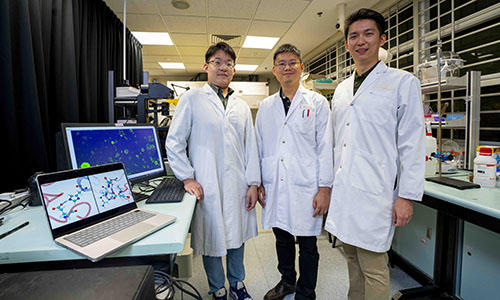NTU Scientists Developed A Versatile Drug Delivery System Inspired by Self-Assembling Protein from Caterpillars
In a landmark study towards revolutionising drug delivery technologies, Associate Professor Yu Jing and his interdisciplinary team have unveiled an innovative drug delivery system, drawing inspiration from the naturally occurring self-assembling
proteins found in the Asian corn borer moth caterpillars (Ostinia furnacalis). This breakthrough, achieved in collaboration with colleagues from Tsinghua University, Dalian University of Technology, and the Chinese Academy of Agricultural Sciences,
presents a promising leap forward in therapeutic delivery technologies.
 The NTU scientists who orchestrated the innovation. From left: Dr Li Haopeng, research fellow from MSE; Assoc Prof Yu Jing from MSE; and Dr Qian Xuliang, research fellow from MAE. Credit: NTU Singapore. |
Harnessing Nature’s Design
Associate Professor Yu’s research, performed in collaboration with former NTU Distinguished University Professor Huajian Gao (now a Xinghua University Professor at Tsinghua University), Professor Liu Tian (Dalian University of Technology), and Professor
Yang Qing (Chinese Academy of Agricultural Sciences), focuses on understanding and utilising the self-assembling properties of proteins within the cuticles of the Asian corn borer moth caterpillar – a common pest affecting corn crops across
regions from China to Australia. The protective cuticle of these caterpillars’ heads is rich in proteins with unique mechanical properties capable of self-assembling into complex structures. Using the self-assembling abilities of proteins derived
from the cuticle, the team succeeded in creating versatile nanocapsules capable of delivering a wide range of therapeutic agents, including small-molecule drugs, proteins, nucleic acids, and mRNA—a key component found in COVID-19 vaccines.
A Novel Approach to Nanocapsule Formation
The research, detailed in the article published in Nature Nanotechnology, introduces a simple, template-free method for generating hollow peptide
nanocapsules that can encapsulate a broad range of therapeutic cargoes. This process, mediated by a solvent concentration gradient that forms when mixing water and acetone, does not require the complex fabrication procedures or templates traditionally
associated with nanocapsule formation. In contrast, the study presents a straightforward one-step mixing method leveraging concentration gradient as the driving force. This allows nanocapsules to form spontaneously without additional steps. Furthermore,
these insect cuticle peptide (ICP) nanocapsules can efficiently encapsulate a wide variety of cargo, including small molecule drugs, proteins, and nucleic acids, and simultaneously load hydrophobic and hydrophilic molecules. The ICP nanocapsules also
demonstrated effective intracellular delivery of various cargoes into human cells with low cytotoxicity and achieved over 90% transfection efficiency in mRNA delivery with specific sequence modifications.
“To the best of our knowledge, this is the first time that peptide nanocapsules have been created without templates, paving the way for a customisable drug delivery system,” remarked Associate Professor Yu Jing. This development opens new
avenues for the treatment of diseases and genetic disorders, offering a versatile and highly promising platform for drug delivery and gene therapy applications.
The team is currently patenting its innovation, underscoring the potential for significant real-world impact and paving the way for the rational design of peptide nanomaterials for biomedical and manufacturing applications. Looking ahead, Associate Professor
Yu and his team plan to harness machine learning to automatically identify other natural self-assembling peptides, further expanding the scope of their research.
Their study exemplifies humanity's enduring quest to unravel nature's mysteries and harness its inherent ingenuity for the benefit of society. By drawing inspiration from the self-assembling proteins found in the Asian corn borer moth caterpillars, Associate
Professor Yu and his team have not only unlocked a new frontier in drug delivery but also demonstrated the immense potential of biomimicry in solving complex scientific challenges. Their groundbreaking research embodies the School and University’s
commitment to engaging in cutting-edge, impactful science that pushes the boundaries of innovation.
Media Features:





.tmb-listing.jpg?Culture=en&sfvrsn=3f725dd6_1)

